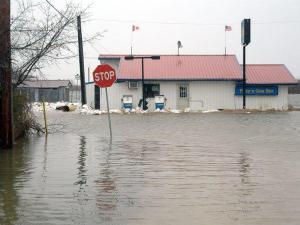
Flooding in Manitoba 2010
There has been much progress made over the past decade in protecting more people in rural communities, with ring dikes waiting to be closed around vulnerable towns. There are still some major gaps in that protection though and still some people who are dislocated due to the flood from 2 years ago. Even those in rural areas whose homes are protected, face huge stress and disruptions with roads being closed, businesses affected and fields underwater. As well, we still have not paid all the bills from the flood of 2011, now thought to cost 1.2billion dollars. One consequence of flooding that remains very problematic is pollution of our waterways and lakes with excess nutrients being washed off the land. We have to assume that Lake Winnipeg and other Prairie lakes will receive another large pulse of phosphorus and nitrogen as the spring melt rushes water off the land and into our streams, rivers and lakes.
Over the last few months the Lake Winnipeg Foundation along with Ducks Unlimited Canada(Manitoba) and the Manitoba Conservations Districts Association have been making joint presentations to diverse audiences, promoting the idea of Keeping Water on the Land. The multiple benefits of holding some water on the land via wetlands include decreasing the severity of floods by slowing down peak flows, building in resiliency for droughts by holding onto water and improving water quality by decreasing run-off of excess nutrients into the streams and rivers. I am encouraged to see this concept gaining momentum in work by American scientists at Oregon State University who have coined the term “re-naturalizing the hydrology”.
We need to start making significant investments in transforming even a small percentage of our landscapes back to its water-storage capacity of last century. There are so many good reasons, economically, socially and environmentally why not doing so could be disastrous.
Leave a comment